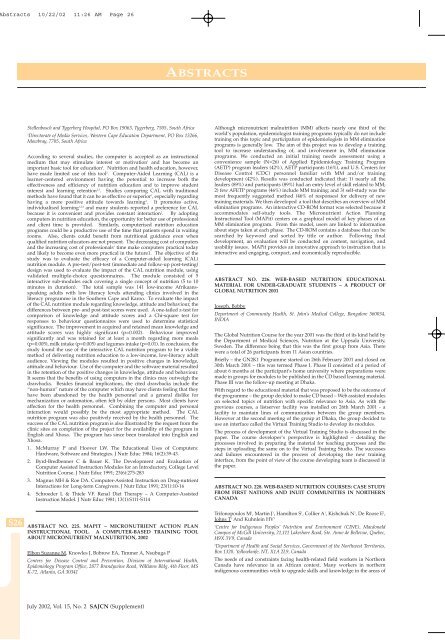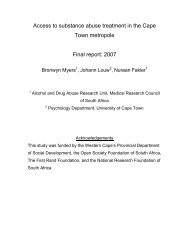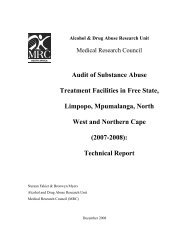Pan-African Conference 21 - 24 July 2002 Inter-Continental Hotel ...
Pan-African Conference 21 - 24 July 2002 Inter-Continental Hotel ...
Pan-African Conference 21 - 24 July 2002 Inter-Continental Hotel ...
Create successful ePaper yourself
Turn your PDF publications into a flip-book with our unique Google optimized e-Paper software.
Abstracts 10/22/02 11:26 AM Page 26<br />
S26<br />
Stellenbosch and Tygerberg Hospital, PO Box 19063, Tygerberg, 7505, South Africa<br />
3 Directorate of Media Services, Western Cape Education Department, PO Box 13266,<br />
Mowbray, 7705, South Africa<br />
According to several studies, the computer is accepted as an instructional<br />
medium that may stimulate interest or motivation1 and has become an<br />
important basic tool for education2 . Nutrition and health education, however,<br />
have made limited use of this tool2 . Computer-Aided Learning (CAL) is a<br />
learner-centered environment having the potential to increase both the<br />
effectiveness and efficiency of nutrition education and to improve student<br />
interest and learning retention2,3 . Studies comparing CAL with traditional<br />
methods have found that it can be as effective or superior1 , especially regarding<br />
having a more positive attitude towards learning4 . It promotes active,<br />
individualised learning1,2,4 and many students reported a preference for CAL<br />
because it is convenient and provides constant interaction2 . By adopting<br />
computers in nutrition education, the opportunity for better use of professional<br />
and client time is provided. Similarly, computerised nutrition education<br />
programs could be a productive use of the time that patients spend in waiting<br />
rooms. Also, clients could benefit from nutritional guidance even when<br />
qualified nutrition educators are not present. The decreasing cost of computers<br />
and the increasing cost of professionals’ time make computers practical today<br />
and likely to become even more practical in the future1. The objective of the<br />
study was to evaluate the efficacy of a Computer-aided learning (CAL)<br />
nutrition module. A pre-test/post-test (immediate and follow-up post-testing)<br />
design was used to evaluate the impact of the CAL nutrition module, using<br />
validated multiple-choice questionnaires. The module consisted of 5<br />
interactive sub-modules each covering a single concept of nutrition (5 to 10<br />
minutes in duration). The total sample was 141 low-income Afrikaansspeaking<br />
adults with low literacy levels attending clinics involved in the<br />
literacy programme in the Southern Cape and Karoo. To evaluate the impact<br />
of the CAL nutrition module regarding knowledge, attitude and behaviour, the<br />
differences between pre- and post-test scores were used. A one-tailed z-test for<br />
comparison of knowledge and attitude scores and a Chi-square test for<br />
responses to behaviour questionnaires were used to determine statistical<br />
significance. The improvement in acquired and retained mean knowledge and<br />
attitude scores was highly significant (p=0.002). Behaviour improved<br />
significantly and was retained for at least a month regarding more meals<br />
(p=0.005), milk intake (p=0.005) and legumes intake (p=0.01). In conclusion, the<br />
study found the use of the interactive CAL nutrition program to be a viable<br />
method of delivering nutrition education to a low-income, low-literacy adult<br />
audience. Viewing the modules resulted in positive changes in knowledge,<br />
attitude and behaviour. Use of the computer and the software material resulted<br />
in the retention of the positive changes in knowledge, attitude and behaviour.<br />
It seems that the benefits of using computers in the clinics may outweigh the<br />
drawbacks. Besides financial implications, the cited drawbacks include the<br />
“non-human” nature of the computer which may have clients feeling that they<br />
have been abandoned by the health personnel and a general dislike for<br />
mechanization or automation, often felt by older persons. Most clients have<br />
affection for the health personnel. Combining the computer and personal<br />
interaction would possibly be the most appropriate method. The CAL<br />
nutrition program was also positively received by the health personnel. The<br />
success of the CAL nutrition program is also illustrated by the request from the<br />
clinic sites on completion of the project for the availability of the program in<br />
English and Xhosa. The program has since been translated into English and<br />
Xhosa.<br />
1. McMurray P and Hoover LW. The Educational Uses of Computers:<br />
Hardware, Software and Strategies. J Nutr Educ 1984; 16(2):39-43.<br />
2. Byrd-Bredbenner C & Bauer K. The Development and Evaluation of<br />
Computer Assisted Instruction Modules for an Introductory, College Level<br />
Nutrition Course. J Nutr Educ 1991; 23(6):275-283<br />
3. Magnus MH & Roe DA. Computer-Assisted Instruction on Drug-nutrient<br />
<strong>Inter</strong>actions for Long-term Caregivers. J Nutr Educ 1991; 23(1):10-16<br />
4. Schroeder L & Thiele VF. Renal Diet Therapy – A Computer-Assisted<br />
Instruction Model. J Nutr Educ 1981; 13(1):S111-S114<br />
ABSTRACT NO. 225. MAPIT – MICRONUTRIENT ACTION PLAN<br />
INSTRUCTIONAL TOOL. A COMPUTER-BASED TRAINING TOOL<br />
ABOUT MICRONUTRIENT MALNUTRITION, <strong>2002</strong><br />
Elbon Suzanne M, Knowles J, Bobrow EA, Timmer A, Nsubuga P<br />
Centers for Disease Control and Prevention, Division of <strong>Inter</strong>national Health,<br />
Epidemiology Program Office, 2877 Brandywine Road, Williams Bldg, 4th Floor, MS<br />
K-72, Atlanta, GA 30341<br />
<strong>July</strong> <strong>2002</strong>, Vol. 15, No. 2 SAJCN (Supplement)<br />
ABSTRACTS<br />
Although micronutrient malnutrition (MM) affects nearly one third of the<br />
world’s population, epidemiologist training programs typically do not include<br />
training on this topic and participation of epidemiologists in MM elimination<br />
programs is generally low. The aim of this project was to develop a training<br />
tool to increase understanding of, and involvement in, MM elimination<br />
programs. We conducted an initial training needs assessment using a<br />
convenience sample (N=26) of Applied Epidemiology Training Program<br />
(AETP) program leaders (42%), AETP participants (16%), and U.S. Centers for<br />
Disease Control (CDC) personnel familiar with MM and/or training<br />
development (42%). Results was conducted indicated that: 1) nearly all the<br />
leaders (89%) and participants (89%) had an entry level of skill related to MM;<br />
2) few AFETP programs (46%) include MM training; and 3) self-study was the<br />
most frequently suggested method (46% of responses) for delivery of new<br />
training materials. We then developed a tool that describes an overview of MM<br />
elimination programs. An interactive CD-ROM format was selected because it<br />
accommodates self-study tools. The Micronutrient Action Planning<br />
Instructional Tool (MAPit) centers on a graphical model of key phases of an<br />
MM elimination program. From this model, users are linked to information<br />
about steps taken at each phase. The CD-ROM contains a database that can be<br />
searched by keyword and sorted by title or author. Following final<br />
development, an evaluation will be conducted on content, navigation, and<br />
usability issues. MAPit provides an innovative approach to instruction that is<br />
interactive and engaging, compact, and economically reproducible.<br />
ABSTRACT NO. 226. WEB-BASED NUTRITION EDUCATIONAL<br />
MATERIAL FOR UNDER-GRADUATE STUDENTS – A PRODUCT OF<br />
GLOBAL NUTRITION 2001<br />
Joseph, Bobby<br />
Department of Community Health, St. John’s Medical College, Bangalore 560034,<br />
INDIA<br />
The Global Nutrition Course for the year 2001 was the third of its kind held by<br />
the Department of Medical Sciences, Nutrition at the Uppsala University,<br />
Sweden. The difference being that this was the first group from Asia. There<br />
were a total of 26 participants from 11 Asian countries.<br />
Briefly – the GN2K1 Programme started on 26th February 2001 and closed on<br />
30th March 2001 – this was termed Phase I. Phase II consisted of a period of<br />
about 6 months at the participant’s home university where preparations were<br />
made in groups for modules to be published in the CD based learning material.<br />
Phase III was the follow-up meeting at Dhaka.<br />
With regard to the educational material that was proposed to be the outcome of<br />
the programme – the group decided to make CD based – Web assisted modules<br />
on selected topics of nutrition with specific relevance to Asia. As with the<br />
previous courses, a listserver facility was installed on 26th March 2001 - a<br />
facility to maintain lines of communication between the group members.<br />
However at the second meeting of the group at Dhaka, the group decided to<br />
use an interface called the Virtual Training Studio to develop its modules.<br />
The process of development of the Virtual Training Studio is discussed in the<br />
paper. The course developer’s perspective is highlighted – detailing the<br />
processes involved in preparing the material for teaching purposes and the<br />
steps in uploading the same on to the Virtual Training Studio. The successes<br />
and failures encountered in the process of developing the new training<br />
interface, from the point of view of the course developing team is discussed in<br />
the paper.<br />
ABSTRACT NO. 228. WEB-BASED NUTRITION COURSES: CASE STUDY<br />
FROM FIRST NATIONS AND INUIT COMMUNITIES IN NORTHERN<br />
CANADA<br />
Trifonopoulos M 1 , Martin J 1 , Hamilton S 1 , Collier A 1 , Kishchuk N 1 , De Roose E 2 ,<br />
Johns T 1 And Kuhnlein HV 1<br />
1Centre for Indigenous Peoples’ Nutrition and Environment (CINE), Macdonald<br />
Campus of McGill University, <strong>21</strong>,111 Lakeshore Road, Ste. Anne de Bellevue, Quebec,<br />
H9X 3V9, Canada<br />
2Department of Health and Social Services, Government of the Northwest Territories,<br />
Box 1320, Yellowknife, NT, X1A 2L9, Canada<br />
The needs of and constraints facing health-related field workers in Northern<br />
Canada have relevance in an <strong>African</strong> context. Many workers in northern<br />
indigenous communities wish to upgrade skills and knowledge in the areas of

















